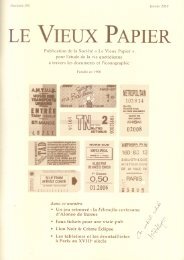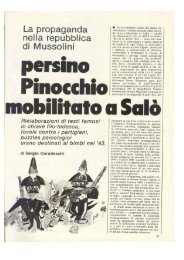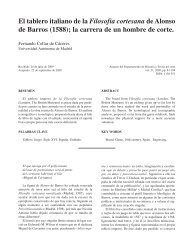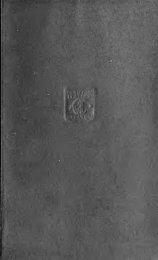Board games from the city of Vijayanagara (Hampi ... - Gioco dell'Oca.
Board games from the city of Vijayanagara (Hampi ... - Gioco dell'Oca.
Board games from the city of Vijayanagara (Hampi ... - Gioco dell'Oca.
Create successful ePaper yourself
Turn your PDF publications into a flip-book with our unique Google optimized e-Paper software.
P. M ICHAELSEN, ON SOME UNUSUAL TYPES OF STICK DICE 17<br />
Several <strong>of</strong> <strong>the</strong> names mentioned are probably very old. Parallels in o<strong>the</strong>r countries<br />
make it very likely that <strong>the</strong>y have <strong>the</strong>ir origin in <strong>the</strong> Middle Ages. Not only ponni, but<br />
also nikkel in names like nikkelstræ, and <strong>the</strong> North Frisian Neggels in Neggels nant, has a<br />
Latin, probably medieval origin. The nichell mentioned by <strong>the</strong> Scottish poet William<br />
Dunbar around 1500 was preserved in Scotland and parts <strong>of</strong> England as nickelty naething<br />
or nickelty nowt, both names referring to <strong>the</strong> N-side <strong>of</strong> <strong>the</strong> teetotum. (27) In <strong>the</strong> Low<br />
German ‘altmärkisch’ dialect <strong>of</strong> Salzwedel, <strong>the</strong> same side was named nig’l-nix. (28) These<br />
words all derive <strong>from</strong> <strong>the</strong> Latin nihil. “Nikolaus” is a folk etymology, which has a parallel<br />
in <strong>the</strong> “Peter” already mentioned and in a “Thomas” <strong>from</strong> Nor<strong>the</strong>rn Jutland, referring<br />
to <strong>the</strong> letter T on one <strong>of</strong> <strong>the</strong> dice faces (which again goes back to an original Latin<br />
totum, preserved as <strong>the</strong> name <strong>of</strong> <strong>the</strong> top in British dialects and in <strong>the</strong> French toton). (29)<br />
Finally, I can add that <strong>the</strong> tradition <strong>of</strong> naming <strong>the</strong> game by putting <strong>the</strong> names <strong>of</strong> <strong>the</strong><br />
four sides <strong>of</strong> <strong>the</strong> dice toge<strong>the</strong>r in one word is likewise rooted in an old tradition. We<br />
have an example <strong>of</strong> this in Gargantua by Rabelais, published in 1534, in which <strong>the</strong> game<br />
is called pille-nade-jocque-fore (‘plunder’, ‘nothing’, ‘game’, ‘out’). (30)<br />
Thus <strong>the</strong> English Lang Larence, at least in its four-sided version, was part <strong>of</strong> a larger,<br />
very old stick dice tradition. This tradition may have had a wider distribution at an<br />
earlier stage.<br />
Dice sticks in outdoor stick <strong>games</strong><br />
Variants <strong>of</strong> <strong>the</strong> stick game, a game <strong>of</strong> physical dexterity played with a long and a<br />
short stick, are found in large parts <strong>of</strong> <strong>the</strong><br />
world, <strong>from</strong> Iceland to Siberia, and <strong>from</strong><br />
Spain to India. The game is old, being<br />
referred to as pandolo in Istrian and Venetian<br />
sources <strong>from</strong> <strong>the</strong> 15th and 16th century, (31) as<br />
cat or tip-cat in English sources <strong>from</strong> <strong>the</strong> 17th<br />
century (32) , and as vippa in a Swedish source<br />
<strong>from</strong> <strong>the</strong> 17th century. (33) It is mentioned<br />
already in an Indian source <strong>from</strong> <strong>the</strong> 5th century<br />
B.C., and in a Turkish source <strong>from</strong><br />
c.1070 A.D. In addition, tip-cat-like sticks<br />
<strong>from</strong> Ancient Egypt (late Middle Kingdom)<br />
have been found during excavations. (34) Some<br />
<strong>of</strong> <strong>the</strong> British variants formed during <strong>the</strong>ir<br />
evolution <strong>the</strong> basis for <strong>the</strong> game <strong>of</strong> Cricket.<br />
As shown by <strong>the</strong> Danish game historian<br />
Frederik Knudsen in 1920 (Fig. 11), <strong>the</strong> short<br />
stick has gradually become smaller and smaller.<br />
(35) Eventually it was replaced by <strong>the</strong> ball,<br />
so that <strong>the</strong> game in its developed form has<br />
undergone a metamorphosis, disappearing as<br />
a stick game, and passing into <strong>the</strong> large fam-<br />
Fig. 11. Short and long sticks for <strong>the</strong><br />
stick game as played on <strong>the</strong> isles <strong>of</strong><br />
Bornholm and Fanø, Denmark.<br />
Fig. 1: Neksø, Bornholm, width 4 cm,<br />
length 9 and 69 cm. Fig. 2: Rønne,<br />
Bornholm, width 3 cm, length 4 and<br />
70 cm. Fig. 3: and 4: Fanø, length 70<br />
and 8,5 cm (fig.3) and 71 and 12 cm<br />
(fig.4). (Drawing by Thor Petersen in<br />
Knudsen 1920).







